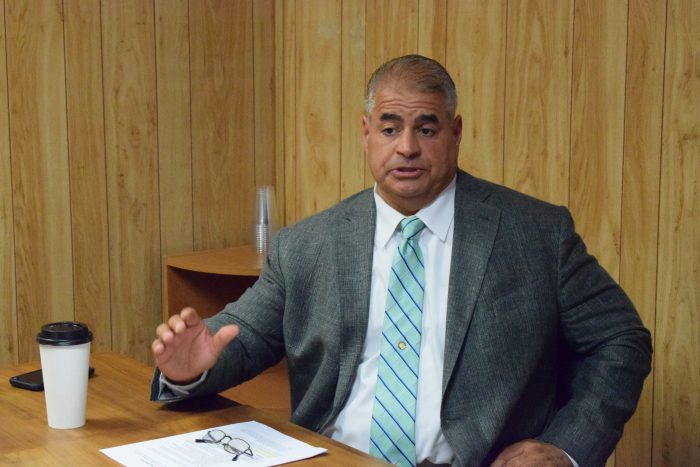On March 4, acting State Supreme Court Justice John Iliou accepted a motion to dismiss criminal charges against Suffolk County Legislator Nick Caracappa (C-Selden) in a domestic violence case.
Caracappa, who took over as majority leader of the county Legislature this year and is the son of the late county Legislator Rose Caracappa, remains under an order of protection for an additional 12 months, after which all charges will be dropped if he obeys the order and stays out of legal trouble.
After newly elected county District Attorney Ray Tierney (R) recused himself from the case, Nassau County District Attorney Anne Donnelly’s office became special prosecutor in January.
The verdict outraged a vocal group of dissenters, who held a demonstration at the William H. Rogers Legislature Building in Hauppauge on March 8, International Women’s Day, calling for Caracappa’s resignation and for greater transparency into the matter.
“The idea that a legislator, who is supposed to create laws to make life better for everyone here, can have such crimes accused of him, and not only keep his job but get promoted, is sickening,” said Leanne Barde, one of the speakers at the event. “Even now, despite whatever deal he has in court, he has not been vindicated.”
Interview with Caracappa
TBR News Media interviewed Caracappa for this story. His ex-wife, whose name is kept anonymous in various reports, is not identified and therefore could not be reached for an interview. TBR News Media would welcome such an interview. Caracappa said he agreed to be interviewed because there are numerous false reports circulating around his private life and asked for his side to be heard.
According to Caracappa, some of his detractors are “professional agitators” who sling mud and stir up controversy for partisan ends. Social media posts obtained by TBR News Media from Caracappa indicate that a coordinated online campaign was launched against him before his reelection bid in 2021. In one such post, Caracappa was referred to as a “convicted criminal abuser who thinks strangling women and possibly buying their silence with a job at the taxpayer expense is justice.”
Caracappa said that the individuals targeting him both online and in the press do not live in his district, do not know him personally and are not familiar with the details of his case. According to him, a careful examination of the timeline of events, spanning from October to December of 2020, would indicate that he was falsely accused.
Caracappa said that his first campaign fundraiser was held on Oct. 14, 2020. Two days later, he received a phone call that his then-wife was having an affair. He confronted her, repeating several times that there was “no violence” during this confrontation. From this incident there precipitated a divorce between the two which was finalized last year.
Caracappa claimed that he and his ex-wife had lived together for two decades without a single accusation of domestic violence made against him. He said the first time police intervened was in November 2020, after he had reported to the police a physical and verbal altercation involving his ex-wife and one of their children.
“I’m with her for 20 years in that house, married 15, and there was never one call to the police on a domestic incident — never once until I made the first call,” Caracappa said. “Now if I had anything to hide, if I was an abuser, would I call the police to my house? Would anybody in their right mind do that?”
According to Caracappa, he served his ex-wife with an order of protection due to the initial incident. He said that approximately three weeks later, his ex-wife retaliated by serving him with her own order of protection on false pretenses.
Caracappa said an alleged assault against his ex-wife would have been nonsensical as he knew he was already under a restraining order.
“Even if I was an abuser, would I abuse someone when I have an order of protection against me?” he said.
Caracappa said he was shocked when police arrested him in December of that year. He contended that his accuser weaponized false allegations against him in an attempt to win more favorable terms in their divorce.
“The timelines don’t add up,” he said. “The statement that was made to the police, being repeated over and over, that I grabbed her throat and that I said this guy [the ex-wife’s alleged partner] is a scumbag and ‘you’re not gonna get half my stuff’ — this is December.” Caracappa added, “I had already been to the [divorce] attorneys, I knew exactly what she was getting and I wasn’t arguing with what she was getting.”
He said that the divorce proceedings were already several weeks underway before any accusation of assault was ever reported to the police. He also suggested that he would not have been granted custody of his daughters if he were abusive toward women.
“I found out [about the alleged affair] on Oct. 16,” he said. “Look at the timeline of events from the order of protections and who did it first. Then I get elected to office and already know what the [divorce] settlements are going to be. Then on Dec. 8 I randomly just do an act of violence on her after 20 years of nothing? She was afraid of losing my daughters, which she did.”
Investigation welcomed
Caracappa said that from the beginning he has welcomed investigators to review the facts. He expressed frustration at the repeated delays and adjournments to his case begun by former Suffolk County District Attorney Tim Sini (D), as Caracappa believed the case could have been settled immediately by a grand jury.
“I wanted the legal process to resolve this issue,” he said. “That is why we demanded a grand jury at the beginning, adjourned over seven times by the past district attorney. If it was so bad, why didn’t they indict me? That is the most simple question you could ask.”
According to Caracappa, the justice system is in place to determine an individual’s guilt or innocence. He believes his detractors have doubled down in their opposition.
“They’re asking for my resignation,” he said. “Why? Because they didn’t get the answer that they wanted, because justice prevailed.”
Caracappa is asking his critics to make a distinction between victims of domestic violence and victims of false accusations. He said this phenomenon has become commonplace among law enforcement.
“It happens to police officers and law enforcement more often than you could ever imagine,” Caracappa said. “They take their guns, they take their badges and they put them on leave because of a divorce. I’ve gotten so many emails, letters and phone calls — from men and women — who are going through the same thing as I am, falsely accused because of a nasty divorce.”
In recent weeks, Caracappa’s detractors have raised questions surrounding the promotion of his ex-wife to a position at Suffolk Off-Track Betting in return for the dismissal of his charges.
“Recent revelations have been reported that the legislator’s alleged victim, in a flabbergasting coincidence, just happened to receive a taxpayer-funded job, paying almost $50,000 per year, with full benefits and a pension, to work for Suffolk OTB,” said Patty Stoddard of Smithtown, one of the activists present at the demonstration, adding that Suffolk OTB is “a known patronage mill.”
Responding to this accusation, Caracappa said his detractors are searching for underlying motives to support their beliefs.
“It’s not true,” he said. “She’s a Republican, she’s a committeeperson, she’s in the system just like anybody else. She has her own friends in the party.” He added, “But I had to get her that job because it sounds good in their story.”
He criticized his dissenters for belittling the independence of his ex-wife, something he considers self-defeating.
“How do they portray [themselves as] standing up for women, but say she’s incapable of getting her own job, that I must have gotten this job for her?” Caracappa said. “Everything is based on their opinion, assumptions, presumptions. Nothing is factually based.”
Caracappa believes his detractors are disruptive to both his private life and to a functional political discourse. When asked how it feels to have his private life brought into public view, he asked that his critics consider the impact that they have on his family.
“It’s incredibly invasive, it’s hurtful,” he said. “You don’t see anything coming from my family. It’s more hurtful to me to have my kids go through this, to have this stuff printed in the paper and have kids bring it into school and show it to my daughter. My daughter knows the truth.”
Caracappa believes the individuals against him either refuse to confront reality or willingly spread misinformation for partisan gain. He said that these individuals do a disservice to the credible work of civic groups that protect victims of domestic violence.
“I feel bad for those groups that have integrity, that actually fight for women and have a history of protecting real victims,” he said. “Not one of those groups came out because they rely on facts. They’re reputable.”









































